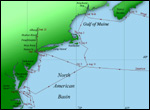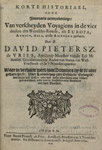Dutch involvement in the exploration of North America began almost accidentally in the spring of 1609, when the Lords Seventeen, the highest authority of the United East India Company (VOC), engaged the English navigator Henry Hudson to try to find a safe passage to the wealthy Spice Islands in the East. At the time, many geographers believed that a short and safe "northeast passage" to Asia could be found that would make it possible to avoid the long trip around the Cape of Good Hope. Hudson had tried unsuccessfully to find such a route on two previous voyages for the English Muscovy Company, sailing as far north as the islands of Novaya Zemlya in the "high" Arctic off the northern coast of Siberia and Spitzbergen, in Svalbard, Norway.
Hudson left Amsterdam on April 6, 1609, aboard the Half Moon, a small, eighty-ton yacht with a crew of eighteen sailors. Sailing along the coast of Norway, he reached the North Cape on May 5. Fearful of another setback in the Arctic waters and worried about quarreling among the Dutch and English sailors on his crew, he made a bold decision to head westward toward North America, following a map that his friend Captain John Smith had shown him. There he hoped to find a westward passage to the Far East - an inlet that would lead to a river across America and into the Pacific.
Hudson made landfall on Labrador and then began to head south along the coast. He entered Chesapeake Bay and stopped briefly at the mouth of the Delaware River before turning north again. In early September he entered what later would come to be called New York Harbor and the Hudson River. Still searching for a passage to the East, the Half Moon sailed almost as far north as present-day Albany before Hudson turned back, convinced by the increasingly shallow water that the river would not lead to the open sea. Although disappointed that he was unable to find the fabled route to Asia, Hudson was impressed by the wealth of the New World. The ship's log describes a country teeming with beaver, deer, and otter and dotted with Indian villages that cultivated corn and beans.
At first, the Dutch were rather slow in exploiting Hudson's discoveries in the New World. Under the terms of its charter, the VOC was legally bound to concentrate its commercial activities in the Far East and thus was not very keen to cross the Atlantic. But these restrictions did not stop individual Dutch merchants and adventurers from reacting to the favorable reports of the New World that circulated in the Netherlands following Hudson's return. Soon, individual ships were crossing the ocean to trade for furs with local Indian tribes.
The most important Dutch navigator to follow in Hudson's path was Captain Adriaen Block, who explored New York and southern New England in 1613-14. Block's ship, the Tiger, was accidentally destroyed in a fire in New York Harbor, whereupon he and his crew built huts and a new ship, the Restless, which Block later used to explore the coast of Long Island. He sailed past a small island off the coast of Rhode Island and charted the location dubbing it "Adriaen's Eylant". Today, the island is known as Block Island.
In 1614 the States-General, or Dutch Parliament, consented to a request by several merchants, primarily from Amsterdam, to form the New Netherland Company and to grant the company an exclusive three-year right to trade in the territory that for the first time was called New Netherland. The new enterprise was such an overwhelming success that merchants excluded from the trade protested fiercely. In response to these complaints, the monopoly was not continued when it came up for renewal in 1618.
De Vries wrote one of the few surviving accounts of the early Dutch travelers to North America. His book includes detailed descriptions of the Indians who lived in the vicinity of present-day New York City and Albany, New York, and an account of his plans to establish a settlement on Staten Island.



